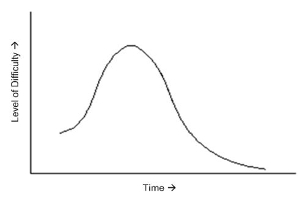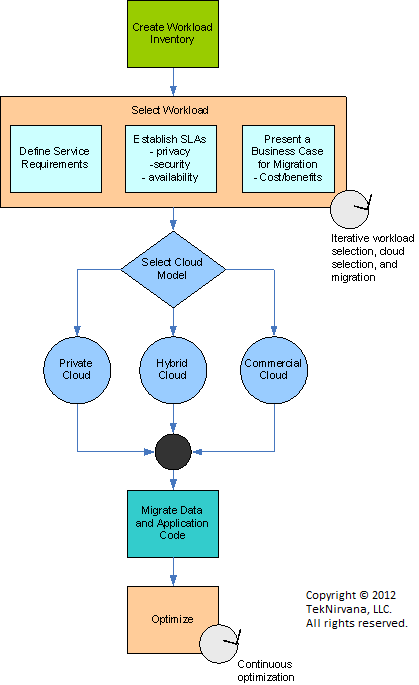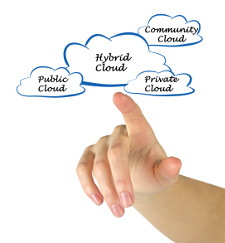|
CloudNirvana™ As IT departments in the private and public sectors embark on their Data Center Consolidation and Cloud Computing journey, they inevitably discover that Cloud computing is the ultimate "paradox of ease." Things that should be difficult are handled by the Cloud with suave finesse. On the other hand, things that might be dismissed as trivial turn into nightmares. So, Cloud Computing is like a two-sided coin with an "easy" side and a "challenging" side. With that analogy in mind, your journey might seem like a series of coin tosses in that in the long run you are likely to have an equal probability of encountering both the "easy" and "challenging" sides of Cloud Computing in no predefined sequence. However, it does not have to be so unpredictable. TekNirvana has charted the journey of early pioneers and found that the seemingly random "coin toss" journey is actually characterized by a well-defined bell-shaped difficulty curve as shown below.
CloudNirvana™ can help With TekNirvana's expert guidance and support, your organization does not have to reinvent the wheel by starting with a less favorable (sharp, steep) difficulty curve and learn everything from scratch. We can help your organization leverage the lessons learned by the early pioneers to accelerate the transition to maturity thereby effectively "flattening" the curve. The CloudNirvana framework for data center consolidation and cloud migration is shown below. 
CloudNirvana's foundation for a successful transition is a robust and stable "governance" structure for the various Cloud-Computing efforts. This includes scoping the cloud capability effort, establishing a business case for cloud services, and defining detailed requirements for cloud services. We establish and leverage risk management practices for acquiring and securing public cloud as well as policies and guidelines on when to use internal private clouds, external public clouds, or hybrid clouds. As shown above, figuring out what applications and data to move to the cloud is a balancing exercise between the acceptable risk and the value obtained from the migration. Risk factors include ensuring that the security level - level of confidentiality, integrity, and availability - of the data and applications is maintained. It also includes having confidence that all applicable privacy related laws will be followed (for example, laws related to trans-border information flow) as well as protection of all intellectual property (IP) rights. The following are three principles (of many) that we leverage as part of our CloudNirvana framework to select and move workloads into the cloud: Start with the low hanging fruit The best applications to start with are standalone and non-mission critical. Examples of applications that work great in a SaaS include E-mail and other collaboration tools such as Live Meeting. Test and Development environments are excellent candidates for PaaS and IaaS. Clouds are also excellent for testing new products, implementing innovation programs, training, workshops, product demonstrations, proof-of-concepts, and implementing disaster recovery/COOP. The same discussion applies to data migration; start with data that has low security requirements and is not subjected to privacy laws. Establish a Sandbox environment An application in the cloud might behave differently than when it did before. Creating a sandbox environment in the cloud allows different user groups to see how a cloud-based application compares to the traditional, non-cloud one. This environment also gives the systems engineers a chance to run functionality and performance testing on the application in the cloud to ensure that it will continue to meet the SLA requirements. Pick your battles - just because it can be done does not mean it should be done Technically speaking, almost anything can be hosted in a cloud - even if an application was not originally designed to be put there. That does not mean all applications and data should be put in a cloud. For one, moving over older applications almost always will involve a case for re-engineering, which is really difficult to justify if the workload is still supporting business objectives in a cost effective and efficient manner. Another point to remember is that Cloud Computing gains its economic edge over a traditional data center when it supports a relatively small simple workload for a huge number of customers. Legacy applications that do not meet these criteria will most likely fail to reap true benefits from the cloud. A final, but truly important, limiting factor is the set of regulations that apply to the service being performed by and the sensitivity level of the data being handled by the workload. |

|
Copyright © 2018 TekNirvana, LLC. All rights reserved.
